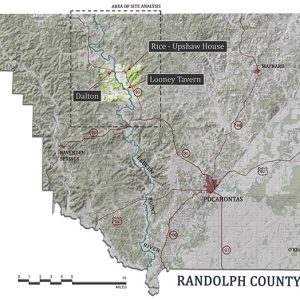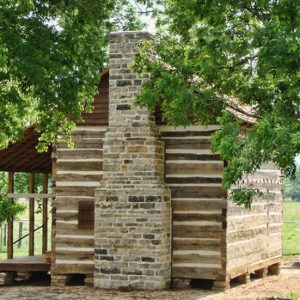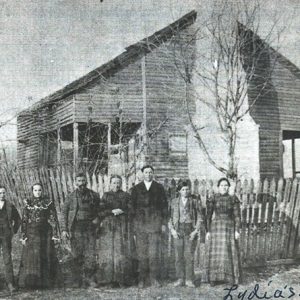calsfoundation@cals.org
Rice-Upshaw House
The Rice-Upshaw House stands on its original site in the Eleven Point River valley near the rural community of Dalton in northwestern Randolph County. Known locally as “Reuben Rice’s,” it was constructed in 1828 by merchant and artisan Reuben Rice to serve as a store and loom house for his 1820s rural trading center. Standing near the Rice-Upshaw House is a 1820s granary. These three structures are among the oldest structures of these kind in the state and represent the state’s only surviving example of a rural trading center.
Reuben Rice arrived in the valley in 1812 by wagon train as part of an inter-connected group of Anglo-American farmers with their few slaves. Settling approximately one mile from Rice and on the opposite side of the river was William Looney, whose 1833 log tavern has been restored and still stands today. Both men were a part of family groups that had been connected in Hawkins County, Tennessee, for decades. In contrast to owners of the large plantations in southern Arkansas, these early yeoman farmers with their few slaves established small farmsteads under the governmental jurisdiction of Missouri Territory and were documented on the 1815 and 1816 Missouri territorial tax lists for Lawrence County (parent county of Randolph County). In 1816, Rice and Looney served as commissioners establishing the area’s first tax-supported roadway to serve their settlements. By the time of the creation of Arkansas Territory in 1819, they already had well-developed and productive farmsteads.
The original first level of the log structure was constructed with one large room and a gable-end fireplace and perhaps served as a store. The Rice family also produced and sold fine fabrics, including linen from flax they grew on the farm. Adjoining the large room is a small side-room created with a log wall partition, a rare surviving feature of American vernacular architecture. In this room, evidence exists for shelving that would have been needed for storage of merchandise, including the cloth the Rices produced for sale.
Standing near the house is a log granary that dates to the 1820s. Records show that the Rice family sold corn and wheat as well as taking these products in trade for other merchandise. The trading center served as a community gathering place, election center, and headquarters for road builders. Although illiterate, Rice became wealthy, expanded his land holdings, served family and friends as administrator and security for numerous estates, and, in 1835, was elected as one of three commissioners to establish the first courthouse for Randolph County, in Pocahontas. While rural trading centers such as Reuben Rice’s were plentiful in the early nineteenth century, Rice’s is the only one in the state to have survived into the twenty-first century.
By the 1840s, Rice, born in 1776, was in retirement. He and his wife, Lydia, both died around 1850. In the mid-1840s, their sixth and youngest son, Thomas Blackman Rice, expanded the original one-story log structure to serve as his family’s home by adding an upper half-story and a stone chimney with two fireboxes for the upper and lower levels. A log smokehouse from the 1840s stands beside the house and speaks to the transition period when the shop/loom house became a dwelling house. A circa 1900 photograph shows Thomas’s daughter, Lydia; her husband, Andrew Jackson Upshaw; and their family standing in front of the further expanded Rice-Upshaw House.
At least five generations of the family have resided in the Rice-Upshaw House, which was placed on the National Register of Historic Places in 2004. That same year, the James Upshaw family, descendants of Reuben Rice, donated the Rice-Upshaw House, granary, smokehouse, and a small acreage to Black River Technical College in Pocahontas to be used for educational purposes. Their donation included several items of nineteenth-century material culture produced by the Rice family, including the loom that arrived with the family on the 1812 wagon train.
The college, with grant funding from the Arkansas Natural and Cultural Resources Council, conducted an intensive multi-disciplinary restoration effort from 2006 to 2011. The Rice-Upshaw House and Site serve as a museum connecting the settlement period in the Eleven Point River valley to vernacular architecture, history, and education in Arkansas. The preservation process and associated discoveries are explained by architects, archaeologists, historians, and educators through multi-media approaches both at the site and through the college’s website under the title of Project REACH—Researching Early Arkansas Cultural Heritage.
For additional information:
“Rice-Upshaw House.” National Register of Historic Places nomination form. On file at the Arkansas Historic Preservation Program, Little Rock, Arkansas. Online at http://www.arkansaspreservation.com/National-Register-Listings/PDF/RA0091.nr.pdf (accessed November 8, 2021).
Joan L. Gould
Fayetteville, Arkansas
 Business, Commerce, and Industry
Business, Commerce, and Industry Historic Preservation
Historic Preservation Louisiana Purchase through Early Statehood, 1803 through 1860
Louisiana Purchase through Early Statehood, 1803 through 1860 Randolph County Sites
Randolph County Sites  Rice-Upshaw Site
Rice-Upshaw Site  Rice-Upshaw House
Rice-Upshaw House  Rice-Upshaw House
Rice-Upshaw House 




Comments
No comments on this entry yet.